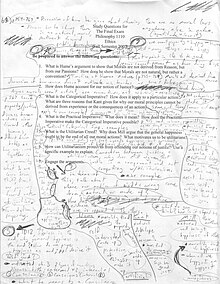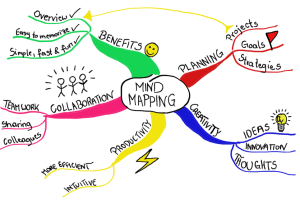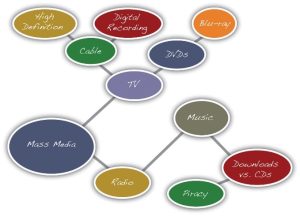12 Prewriting & Brainstorming
Every writing assignment from every discipline requires the formulation of complex ideas. Thus, once the assignment guidelines have been thoroughly considered, you should begin to explore how you plan to structure your work in order to meet them. While this is often considered to be the start of the writing process, it is also an essential part of assignment analysis, as it is here that the assignment is broken down into the most digestible parts. Such a process can be done either individually or in a group, depending on the situation.
Prewriting:
The first and foremost stage of the individual writing process is that of Prewriting. Often overlooked by inexperienced writers, this is essentially the architectural stage of the writing/analysis process, where the foundations of an assignment are first laid out and constructed. Free-writing, outlining, diagramming, and mapping are all possible approaches to this stage of development, where the goal is to organize one’s ideas around the requirements of the task at hand. Many people begin this right on the assignment sheet, as it can be helpful to highlight what the instructor is specifically asking for while simultaneously adding one’s own understanding to the ideas. Eventually though, you will want to move to a separate page.
- If you are free-writing, you should start by writing out an assignment related question or main concept, and then proceed to freely (with or without punctuation or formality) write anything that comes to mind in relation to it.
- If you are outlining, you are essentially breaking down the main ideas of the assignment and your response to them in a linear format (by paragraph, subject, section, subsection etc.).
- If you are diagramming, your prewriting can take many different forms, but always as a visual representation of your response to some/all of the assignment constituents.
- If you are mapping, you are essentially outlining in a more visual way, using both linear and non-linear representation to organize your ideas about the assignment.
Research can also be conducted during this stage of the writing/analysis process, as it is sometimes helpful to know more about a topic before you make the commitment to writing about it. You may even choose to use more than one of these approaches if you find it helpful in developing your understanding of the assignment.

Brainstorming:
Similar to prewriting, brainstorming takes place in the space between analysis and drafting and can be a solo excursion or one that involves group discussions and a sharing of ideas. The size of a brainstorming group varies according to task, but ideally consists of smaller odd numbers (3, 5, or 7) when there is no assigned mediator present. There are obviously many pitfalls to such group discussion, and many divergent possibilities (distractions, freeloading, repetition, etc.) that can lead to counter- productivity. Nonetheless, if all members are devoted to the task of analysis and development, the variety of perspectives can prove to be most rewarding.
If all goes well, each member of the group takes turns posing questions related to the assignment being discussed, to which the other members respond openly and freely. When positive attitudes and constructive criticism can be maintained, each member of the group will have his or her own critical thinking expanded upon and enriched by the understanding of the other group members.
Brainstorming and Idea Mapping
Just like with prewriting, there are far too many ways to list effective brainstorming strategies, but we have given some examples of popular ones below.
Visual brainstorming techniques like idea mapping, also known as clustering, spider-maps, or mind-mapping, allow you to develop and organize your thoughts by creating a visual representation of your ideas. These visualizations help writers break down concepts and group them together to identify how different ideas relate or connect. By using circles, lines, and arrows, these maps can reveal a more focused topic and provide purpose and organization for a writing assignment.
When Is Clustering/Spider Mapping Useful?
As depicted below, writers use clustering to help sketch out ideas and suggest logical connections. In this way, writers use cluster diagrams and spider maps as an invention tool. When clustering, they do not impose an order on their thinking. Instead, after placing the idea in the center of the page, they then free-associate.
Remembering that the goal is to generate ideas, make the drawing visually attractive, perhaps using color or a variety of geometric shapes and layout formats. Typical cluster and spider maps resemble the following:

- Branches: If ideas seem closely related to you, consider using small branches, like tree limbs, to represent their similarities.
- Arrows: Use arrows to represent processes or cause and effect relationships.
- Groupings: If a number of ideas are connected, go ahead and put a circle around them.
- Bullets: List ideas that seem related.
In addition to being a powerful invention strategy, idea maps can also be used to represent complex relationships for readers. The image below demonstrates how a mind-map can be used to narrow down a general topic into a specific focus for a writing assignment.

Notice the largest circle contains the general topic, Mass Media. Then, the general topic branches into two subtopics written in two smaller circles: television and radio. The subtopic, television, branches into even more specific topics: cable and DVDs. From there, the author drew more circles and wrote more specific ideas: high definition and digital recording from cable, and Blu-ray from DVDs. The radio topic led the author to draw connections between music, downloads versus CDs, and, finally, piracy.
From this idea map, the author saw they could consider narrowing the focus of their topic of Mass Media to the more specific topic of Music Piracy.
Journalistic Questions
provided by Writing Commons
| Question | ||
| 1. Who? | Who is doing this? | Who will do this? |
| 2. What? | What did they do? | What was it for? |
| 3. Where? | Where did they do it? | Where is it going to happen? |
| 4. Why? | Why are they doing this? | Why are they doing it? |
| 5. When? | When is it happening? | When is it going to happen? |
| 6. How? | How did they do it? | How do they hope to do it? |
By answering these questions, the author can begin to understand their topic a little better and can begin to think about the rhetorical situation of the writing they plan to produce.
USING AI TO HELP WITH BRAINSTORMING
AI is a sophisticated and powerful tool. There are many ways in which we can use AI to help us brainstorm topics. However, because the AI landscape is still pretty much the wild west of technology development, all we can offer are the following suggestions:
- Use an AI program you can trust (chatGPT, Microsoft Copilot, Google Gemini, etc.). Not all AI is going to be good or helpful.
- Practice with creating a brainstorming prompt that will help you return a list of ideas that is helpful
- Don’t stop at the first prompt.
- Make notes about some of the ideas that AI has returned so that you can continue to make your prompt more useful to your needs.
Whichever prewriting or brainstorming techniques you choose, make sure that they work for you and your current project. You can employ different techniques depending on what you are being asked to accomplish. If I am being asked to complete a technical piece, like a syllabus, I pull up a template or an outline and work from that. If I am asked to work on a larger project, like this book, then I work with my group and we employ strategies that range from outlines, word walls, tables and charts, to whiteboards filled with ideas that we can change and adapt as we work. I challenge you to explore the options available and find what works best for you.
Licenses and Attributions CC LICENSED CONTENT,
Composing Ourselves and Our World, Provided by: the authors. License: Attribution 4.0 International (CC BY 4.0)
CC LICENSED CONTENT INCLUDED
This chapter contains an adaptation from 8.1 Apply Prewriting Models by University of Minnesota and is licensed under a Creative Commons Attribution-NonCommercial-ShareAlike 4.0 International License.
This chapter contains an adaptation of Ten Ways To Think About Writing: Metaphoric Musings for College Writing Students by E. Shelley Reid This work is licensed under the Creative Commons Attribution- Noncommercial-Share Alike 3.0 license.
Media Attributions
- image8
- image10
- image9

